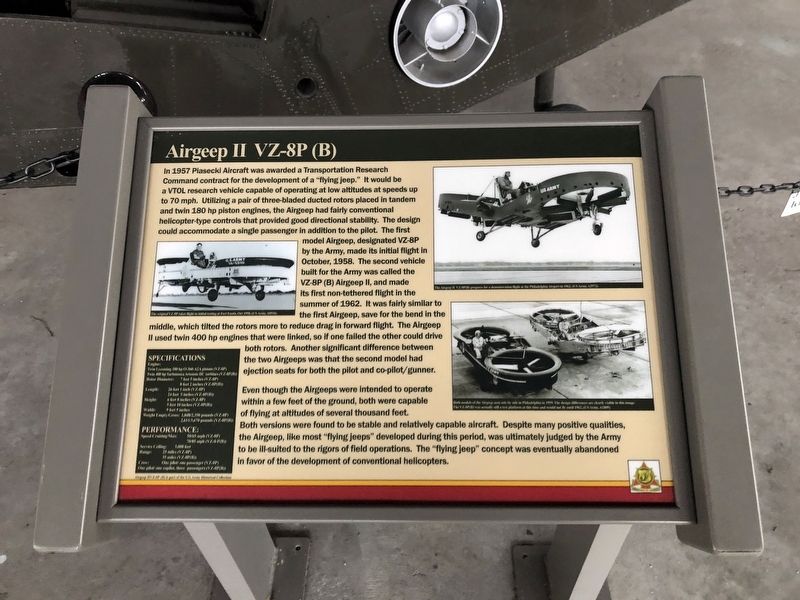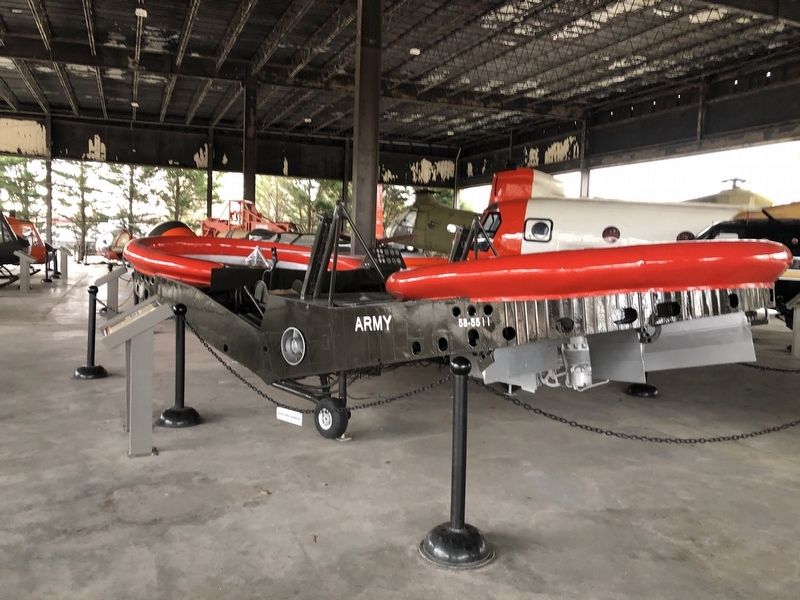Fort Eustis in Newport News, Virginia — The American South (Mid-Atlantic)
Airgeep II VZ-8P (B)
In 1957 Piasecki Aircraft was awarded a Transportation Research Command contract for the development of a "flying jeep." It would be a VTOL research vehicle capable of operating at low altitudes at speeds up to 70 mph. Utilizing a pair of three-bladed ducted rotors placed in tandem and twin 180 hp piston engines, the Airgeep had fairly conventional helicopter-type controls that provided good directional stability. The design could accommodate a single passenger in addition to the pilot. The first model Airgeep, designated VZ-8P by the Army, made its initial flight in October, 1958. The second vehicle built for the Army was called the VZ-8P (B) Airgeep II, and made its first non-tethered flight in the summer of 1962. It was fairly similar to the first Airgeep, save for the bend in the middle, which tilted the rotors more to reduce the drag in forward flight. The Airgeep II used twin 400 hp engines that were linked, so if one failed the other could drive both rotors. Another significant difference between the two Airgeeps was that the second model had ejection seats for both the pilot and co-pilot/gunner.
Even though the Airgeeps were intended to operate within a few feet of the ground, both were capable of flying at altitudes of several thousand feet. Both versions were found to be stable and relatively capable aircraft. Despite
many positive qualities, the Airgeep, like most "flying jeeps" developed during this period, was ultimately judged by the Army to be ill-suited to the rigors of field operations. The "flying jeep" concept was eventually abandoned in favor the development of conventional helicopters.Erected by US Army Transportation Museum.
Topics. This historical marker is listed in these topic lists: Air & Space • War, Cold. A significant historical month for this entry is October 1958.
Location. 37° 9.839′ N, 76° 34.593′ W. Marker is in Newport News, Virginia. It is in Fort Eustis. Marker can be reached from Washington Boulevard just north of Jefferson Avenue, on the right when traveling north. Touch for map. Marker is at or near this postal address: 321 Washington Blvd, Fort Eustis VA 23604, United States of America. Touch for directions.
Other nearby markers. At least 8 other markers are within walking distance of this marker. U-6A Beaver (here, next to this marker); GEM, Model 2500 Air Car (here, next to this marker); CH-37 Mojave (a few steps from this marker); U-1A Otter (a few steps from this marker); H-25A Mule (a few steps from this marker); VH-34C / H-34C Choctaw (a few steps from this marker); Doak 16 VZ-4DA (a few steps from this marker); YAC-1 / CV-2 / CV-7 Caribou (a few steps from this marker). Touch for a list and map of all markers in Newport News.
Credits. This page was last revised on February 1, 2023. It was originally submitted on February 28, 2021, by Devry Becker Jones of Washington, District of Columbia. This page has been viewed 214 times since then and 27 times this year. Photos: 1, 2. submitted on February 28, 2021, by Devry Becker Jones of Washington, District of Columbia.

